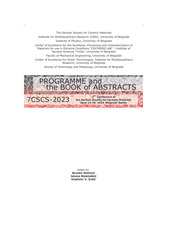| dc.creator | Vukašinović, Jelena | |
| dc.creator | Počuča-Nešić, Milica | |
| dc.creator | Malešević, Aleksandar | |
| dc.creator | Zemljak, Olivera | |
| dc.creator | Podlogar, Matejka | |
| dc.creator | Drev, Sandra | |
| dc.creator | Bernik, Slavko | |
| dc.creator | Branković, Goran | |
| dc.date.accessioned | 2023-08-16T17:24:32Z | |
| dc.date.available | 2023-08-16T17:24:32Z | |
| dc.date.issued | 2023 | |
| dc.identifier.isbn | 978-86-80109-24-4 | |
| dc.identifier.uri | http://rimsi.imsi.bg.ac.rs/handle/123456789/2074 | |
| dc.description.abstract | Barium-stannate (BaSnO3, BSO) is a member of the perovskite-type alkaline
earth stannates ASnO3 (A = Ca, Sr, Ba) with an ideal cubic crystal structure (space
group: ). Doping with antimony (Sb5+) can change this wide band-gap
semiconductor (Eg = 3.1-3.4 eV) into an n-type semiconductor with high electrical
conductivity at room temperature. The major drawbacks in the BSO-based ceramics
synthesis are phase composition and low density of final ceramic materials. These
problems could be solved using spark plasma sintering (SPS), a current and
pressure-assisted technique, which enables the preparation of dense ceramics at
significantly lower temperatures and for a shorter time.
To investigate the influence of spark plasma sintering temperature on the
structural, microstructural and electrical properties of BaSn1-xSbxO3 (BSSO, x =
0.00; 0,04; 0.06; 0.08; and 0.10) ceramics samples, BSSO powders were spark
plasma sintered at 1100 °C, 1200 °C and 1250 °C for 5 min.
X-ray diffraction (XRD) analysis confirmed that all ceramic samples sintered at
1100 °C crystallized in a single-phased cubic BSO structure. Their relative densities
were in the range of 72–82% ρt. Sintering at 1200 °C increased the samples’ relative
densities to 79–96% ρt, but also induced the formation of a barium-rich secondary
phase, Ba2SnO4. Rising the sintering temperature further to 1250 °C induced the
melting of all samples except BaSn0.92Sb0.08O3. Field emission scanning electron
microscopy (FE-SEM) revealed that doping with antimony decreased the grain sizes
in BSSO samples sintered at 1100 °C and 1200 °C up to the concentration x = 0.08.
Electrical measurements revealed the typical semiconductor behavior of the
undoped samples, showing nonlinear current-voltage characteristic and the existence
of one semicircle in their impedance spectra, characteristic for materials with double
Schottky barrier at the grain boundaries. However, samples with higher dopant
concentrations (x = 0.08 and 0.10) showed significantly lower electrical resistivity
and linear current-voltage characteristic. The lowest and almost constant value of
electrical resistivity in the temperature range of 25–150 °C, and complete loss of the
semicircle in its impedance spectrum revealed the metallic-like behavior of sample
BaSn0.92Sb0.08O3 sintered at 1200 °C. | sr |
| dc.language.iso | en | sr |
| dc.publisher | University of Belgrade, Institute for Multidisciplinary Research | sr |
| dc.relation | info:eu-repo/grantAgreement/MESTD/inst-2020/200053/RS// | sr |
| dc.rights | openAccess | sr |
| dc.source | 7th Conference of the Serbian Society for Ceramic Materials, 7CSCS-2023, June 14-16, 2023, Belgrade, Serbia | sr |
| dc.subject | Barium stannate | sr |
| dc.subject | n-type semiconductor | sr |
| dc.subject | Pressure-assisted technique | sr |
| dc.subject | SPS | sr |
| dc.subject | Schottky barrier | sr |
| dc.subject | Electrical resistivity | sr |
| dc.title | The influence of spark plasma sintering temperature on the properties of Sb-doped barium stannate ceramics | sr |
| dc.type | conferenceObject | sr |
| dc.rights.license | ARR | sr |
| dc.citation.spage | 86 | |
| dc.identifier.fulltext | http://rimsi.imsi.bg.ac.rs/bitstream/id/5479/bitstream_5479.pdf | |
| dc.identifier.rcub | https://hdl.handle.net/21.15107/rcub_rimsi_2074 | |
| dc.type.version | publishedVersion | sr |

